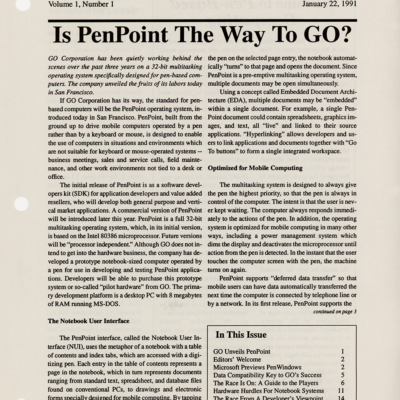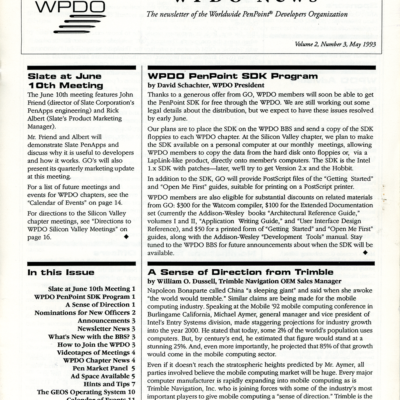Introduction
Excepteur sint occaecat cupidatat non proident, sunt in culpa qui officia deserunt mollit laborum. Sed ut perspiciatis unde omnis iste natus sit voluptatem accusantium doloremque laudantium totam rem aperiam, eaque ipsa quae ab.
Illo inventore veritatis et quasi architecto beatae vitae dicta sunt explicabo. Nemo enim ipsam voluptatem quia voluptas sit aspernatur aut odit aut fugit, sed quia consequuntur magni dolores eos qui ratione voluptatem sequi nesciunt. Neque porro quisquam est, qui dolorem ipsum quia dolor sit amet, consectetur, adipisci velit, sed quia non numquam eius modi tempora incidunt ut labore et dolore magnam aliquam quaerat voluptatem.
The Original Article/Press Release
Palm Computing Delivers Major Advance in Handwriting Recognition Technology
Sept. 19, 1994 – Palm Computing Monday announced Graffiti power writing technology, a new method of entering text into handheld computers with a pen.
Graffiti will support all major pen-based computing platforms including Apple’s Newton, General Magic’s Magic Cap, GEOS from Geoworks, Microsoft Windows for Pen Computing, Microsoft Winpad and PenRight! Current shipping Personal Digital Assistants (PDAs) which will take advantage of Graffiti add-on software include the Apple Newton MessagePad, AST Gridpad 2390, Casio Z-7000, Sharp Expert Pad PI-7000 and Tandy Z-PDA Zoomer.
Graffiti represents a major advance in handwriting recognition technology by delivering instant and accurate recognition.
Graffiti works with a simplified version of the existing alphabet. The user enters pre-defined strokes for each letter, Graffiti then translates that stroke into the corresponding text character on the computer screen. Testing has revealed that most users can learn to enter these strokes fast enough to achieve more than 30 words per minute with 100% accuracy.
Because Graffiti works with a basic modification of the existing alphabet, most users become competent with Graffiti in less than 20 minutes.
Graffiti is being supported as an optional text entry method by a wide range of handheld computing developers including: Apple Computer, Casio Corp., Hewlett Packard, Motorola, Sharp Electronics and Tandy Corp.
“Palm Computing’s introduction of Graffiti marks an important milestone in the development of the mobile communications market,” said Rhonda Dirvin, director PDA marketing, Motorola Personal Portable Systems. “Motorola is excited about the reliability and flexibility of this new handwriting recognition and believes Graffiti will be a key enabling technology for a variety of handheld communications devices.”
High Speed and Accuracy Reduces User Frustration
By increasing the uniqueness of each character, Palm has developed a system which is highly accurate, therefore addressing the major frustration of current handheld computer users: predictability. If the correct strokes representing a letter in the alphabet are entered, users will achieve 100% recognition accuracy.
Graffiti’s efficient pattern recognition algorithm combined with the simplified alphabet provide almost instant character recognition on all supported systems. This results in an immediate response for the user.
Each time the user writes a stroke, the electronic ink is instantly translated into a text character. The user gains control by immediately verifying the information, which provides the opportunity to instantly correct mistakes. The sensation of using Graffiti is very similar to typing on a keyboard. When the user hits a key (strokes a character) a letter appears on the screen.
Graffiti Allows Users to Write Almost Any Character
Graffiti covers many characters which are impossible to achieve with current recognition technology including accented characters, punctuation and symbols. Capitalization, punctuation, numbers and symbols are handled similarly to a keyboard. When the user wants to input a capital letter in Graffiti, they “shift” Graffiti into uppercase through a simple upstroke.
The letter following the upstroke is then capitalized. Graffiti has shifts for caps lock and numbers, enabling users to enter strokes similar to the actual characters of the Roman alphabet without confusing a “1” and an “I”, or a “5” and an “S”. These strokes are never confused by the Graffiti system.
“We’ve been very impressed with the completeness of the Graffiti system,” said Richard C. Watts, vice president and general manager of Hewlett Packard’s Personal Information Products Group. “Graffiti provides easy access to accented characters, symbols and punctuation which are difficult to achieve with standard recognition systems.”
Graffiti Enables Future Generation of Pocket Sized Devices
Because Graffiti provides an immediate response to each stroke of the pen, user do not need to write out words or sentences, but rather can write one character on top of another. By not looking at the screen, the Graffiti user can concentrate on the speaker or the document they are transcribing. Further, since the user can write in a small area on the screen, wide acceptance of Graffiti may result in the development of smaller devices with smaller screens for entering data.
“Graffiti is a significant technology breakthrough which enables development of pocket-sized devices with robust data input capabilities,” said Doug Brackbill, vice president, Mtel Advanced Applications Group. “We think Graffiti will spur the growth of new markets for wireless messaging.”
Through the use of Graffiti’s ShortCuts, large blocks of text can be entered into the system with a few pen strokes. With ShortCuts a user can build a library of frequently used phrases, and easily recall any of them with a few strokes of the pen. For instance, the user may create a thank you note which they often fax to customers. By inputting the ShortCuts “shift” stroke and, for example, “th” for thank you, Graffiti will recall the entire predefined block of text.
Graffiti User Testing Shows High Level of Satisfaction
Palm Computing conducted extensive user testing with Newton and Zoomer owners, as well as non-PDA users. Ninety five percent of test subjects who owned a Newton or Zoomer wanted Graffiti after testing. Ninety seven percent of the Graffiti alphabetical characters were recalled by users after a week of non-use. Several device manufacturers have conducted their own user testing and found similar results.
“Our Graffiti user testing has been overwhelmingly positive,” said Ed Colligan, vice president marketing for Palm Computing. “Nearly all users tested learned the system in under 20 minutes and became proficient in less than 2 hours. Most users showed an extremely high level of satisfaction. These results lead us to believe that Graffiti will become a major method of data entry for pocket-sized computers.”
Graffiti is based on Palm’s patented recognition algorithms. Palm has other patents pending on broad elements of Graffiti’s unique functionality.
Product, Pricing and Availability
Graffiti includes the core recognition software which users download to their handheld device, and an online tutorial and help system. A trial copy of Graffiti is available directly from Palm Computing by calling 800/881-PALM or through America Online, Compuserve or the Internet. Graffiti is priced at $79 and is immediately available for the GEOS and Magic Cap platforms by calling 800/881-PALM.
Graffiti for Newton will be available Q4 1994 direct from Palm Computing and wherever Newtons are sold. Graffiti for PenRight! is available to potential vertical customers for evaluation. Graffiti for Windows for Pen Computing and Winpad are under development and slated for release next year.
Palm Computing is the leading independent provider of application software for consumer focused handheld computers. Headquartered in Los Altos, its products include personal information management applications, desktop to handheld computer connectivity software, PalmPrint handwriting recognizer and Graffiti power writing technology.
CONTACT:
Palm Computing Inc., Los Altos
Ed Colligan, 415/949-9742
Cathy Cain, 415/949-9874
This is an annotation….
This is another annotation….
Related Artifacts
Comments
“This is a quote that will be included with this page…”
John Jerney
Publisher
Pen-Based Computing




